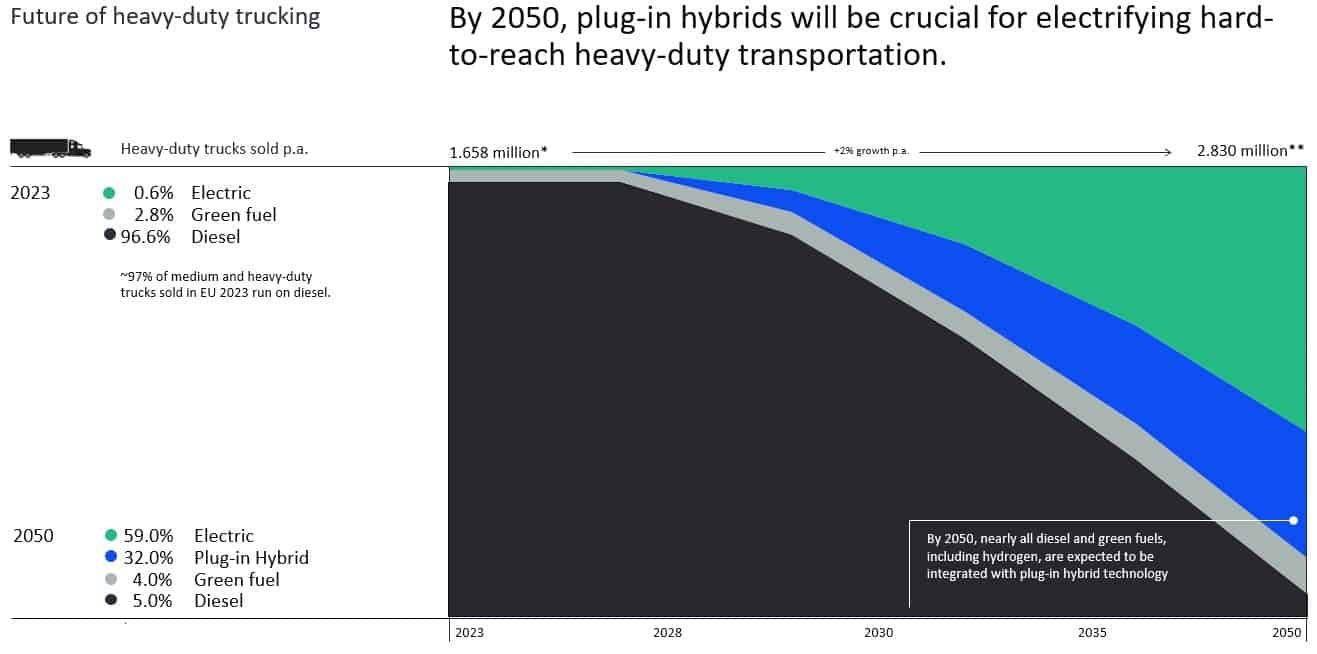Future of Heavy-Duty Trucks: Rise of Plug-in Hybrids by 2050?

Picture provided by Brudeli Green Mobility
Abstract
The future of heavy-duty trucking is poised for a significant transformation, driven by the need to reduce emissions and improve energy efficiency. As illustrated by recent projections, the shift from diesel-dominated fleets to more sustainable alternatives is inevitable. By 2050, plug-in hybrid trucks are expected to play a crucial role in this transition, particularly in hard-to-electrify segments of the industry. This article analyzes the projected changes in the heavy-duty truck market, focusing on the increasing adoption of electric, plug-in hybrid, and green fuel technologies, and the corresponding decline in diesel usage.
Introduction
The heavy-duty trucking industry is a cornerstone of global commerce, responsible for transporting vast quantities of goods across continents. Traditionally powered by diesel engines, these trucks have long been associated with high levels of greenhouse gas emissions and other pollutants. However, as climate change concerns intensify and regulatory pressures mount, the industry is increasingly looking toward alternative powertrains. According to projections from key industry reports, the composition of heavy-duty truck sales is expected to undergo dramatic changes by 2050, with plug-in hybrids emerging as a vital technology.
Current Market Landscape (2023)
As of 2023, the heavy-duty truck market remains overwhelmingly dominated by diesel-powered vehicles. Approximately 96.6% of all medium and heavy-duty trucks sold in the European Union (EU) are diesel-powered, highlighting the current dependence on this fuel. Electric vehicles (EVs) and green fuels, such as hydrogen, represent a small fraction of the market, with EVs accounting for just 0.6% of sales and green fuels contributing 2.8%.
This status quo is largely driven by the robustness, reliability, and extensive refueling infrastructure associated with diesel engines. However, the environmental impact of diesel, coupled with the EU’s ambitious emissions reduction targets, underscores the need for a shift toward more sustainable alternatives.
Projected Market Shift (2023-2050)
1. Rise of Electric and Plug-In Hybrid Vehicles
By 2050, the heavy-duty truck market is expected to undergo a profound transformation. Electric trucks are projected to comprise 59% of new truck sales, reflecting the increasing feasibility of battery electric vehicles (BEVs) as battery technology advances, and charging infrastructure becomes more widespread. BEVs will likely dominate short-haul and urban delivery segments, where range limitations are less of a concern.
Plug-in hybrid electric vehicles (PHEVs) are forecasted to account for 32% of the market, a significant increase from their near-negligible presence today. This surge in PHEV adoption is driven by their ability to offer the best of both worlds: electric power for low-emission zones and urban environments, and a conventional engine for long-haul journeys where charging infrastructure may still be lacking. PHEVs thus provide a critical bridging technology, ensuring that heavy-duty trucking can meet both current operational demands and future environmental standards.
2. Decline of Diesel and Green Fuels
The same period will witness a sharp decline in diesel’s dominance, with its market share expected to plummet to just 5% by 2050. This decline is attributed to increasingly stringent emissions regulations, rising fuel costs, and the growing availability of viable alternatives. Even green fuels, such as hydrogen, which are often seen as part of the future energy mix, will only represent 4% of the market. Notably, many of these green fuel-powered vehicles are anticipated to incorporate plug-in hybrid systems to maximize efficiency and range.
The Role of Plug-In Hybrids
Plug-in hybrid trucks will be especially crucial in sectors of heavy-duty transportation that are difficult to fully electrify. For instance, long-haul trucking and operations in remote areas, where charging infrastructure is sparse, will benefit from the extended range and flexibility offered by PHEVs. These vehicles can run on electric power in emission-sensitive areas and switch to conventional fuel for extended highway driving, thereby reducing overall emissions without compromising on range or operational efficiency.
Moreover, the integration of plug-in hybrid technology with green fuels like hydrogen could provide a pathway to even lower emissions, combining the benefits of zero-emission driving in urban settings with the longer-range capabilities of traditional fuels.
Challenges and Considerations
Despite the promising outlook for plug-in hybrids, several challenges remain. The higher initial costs of PHEVs compared to traditional diesel trucks may hinder adoption, especially among smaller fleet operators. Additionally, the development of charging infrastructure and the continued evolution of battery technology are critical to realizing the full potential of PHEVs. Policymakers and industry stakeholders must work together to address these challenges through incentives, investments in infrastructure, and continued research and development.
Conclusion
The future of heavy-duty trucking is set to be far more diverse in terms of powertrain technologies than it is today. By 2050, plug-in hybrid trucks are expected to play a pivotal role in the industry’s efforts to reduce emissions and improve energy efficiency, particularly in segments where full electrification remains challenging. As the industry continues to evolve, the strategic adoption of PHEVs, along with the expansion of electric and green fuel technologies, will be key to meeting both environmental goals and operational demands.
References
- Volvo Annual Report 2023. (2023). Detailed analysis of the heavy-duty truck market and powertrain transitions.
- International Energy Agency (IEA). (2023). “Net Zero by 2050: A Roadmap for the Global Energy Sector.” IEA. Net Zero by 2050: A Roadmap for the Global Energy Sector – Video Event – IEA
- Brudeli Green Mobility: Projections based on dialogue/inside from Original Equipment Manufacturers (OE). (2023). Industry insights into the future of heavy-duty truck powertrains.


